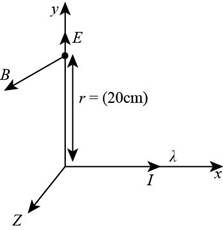
Concept explainers
(a)
The electric field the rod creates at the point ( x = 0 , y = 20.0 cm , z = 0 )
(a)
Answer to Problem 34.6P
Explanation of Solution
Given info: The linear density of the rod is
The value of permittivity of free space is
The figure given below shows the location of the thin rod with respect to axis.

Figure (1)
The formula for the electric field due to long wire is,
Here,
Substitute
Conclusion:
Therefore, the electric field the rod creates at the point
(b)
The magnetic field the rod creates at the point ( x = 0 , y = 20.0 cm , z = 0 )
(b)
Answer to Problem 34.6P
Explanation of Solution
Given info: The linear density of the rod is
The value of the permeability constant is
The expression for the current in the wire is,
Here,
Substitute
Thus, the current in the wire is
The formula for the magnetic flux due to wire is,
Here,
Substitute
Conclusion:
Therefore, the magnetic field the rod creates at the point
(c)
The force exerted on an electron at point ( x = 0 , y = 20.0 cm , z = 0 ) ( 2.40 × 10 8 ) i ^ m / s
(c)
Answer to Problem 34.6P
Explanation of Solution
Given info: The linear density of the rod is
The charge on an electron is
The Lorentz force on the electron is,
Here,
Substitute
Conclusion:
Therefore, the force exerted on an electron at point
Want to see more full solutions like this?
Chapter 34 Solutions
Physics for Scientists and Engineers, Technology Update, Hybrid Edition (with Enhanced WebAssign Multi-Term LOE Printed Access Card for Physics)
- Hi! I need help with these calculations for part i and part k for a physics Diffraction Lab. We used a slit width 0.4 mm to measure our pattern.arrow_forwardExamine the data and % error values in Data Table 3 where the angular displacement of the simple pendulum decreased but the mass of the pendulum bob and the length of the pendulum remained constant. Describe whether or not your data shows that the period of the pendulum depends on the angular displacement of the pendulum bob, to within a reasonable percent error.arrow_forwardIn addition to the anyalysis of the graph, show mathematically that the slope of that line is 2π/√g . Using the slope of your line calculate the value of g and compare it to 9.8.arrow_forward
- An object is placed 24.1 cm to the left of a diverging lens (f = -6.51 cm). A concave mirror (f= 14.8 cm) is placed 30.2 cm to the right of the lens to form an image of the first image formed by the lens. Find the final image distance, measured relative to the mirror. (b) Is the final image real or virtual? (c) Is the final image upright or inverted with respect to the original object?arrow_forwardConcept Simulation 26.4 provides the option of exploring the ray diagram that applies to this problem. The distance between an object and its image formed by a diverging lens is 5.90 cm. The focal length of the lens is -2.60 cm. Find (a) the image distance and (b) the object distance.arrow_forwardPls help ASAParrow_forward
 Principles of Physics: A Calculus-Based TextPhysicsISBN:9781133104261Author:Raymond A. Serway, John W. JewettPublisher:Cengage Learning
Principles of Physics: A Calculus-Based TextPhysicsISBN:9781133104261Author:Raymond A. Serway, John W. JewettPublisher:Cengage Learning Physics for Scientists and EngineersPhysicsISBN:9781337553278Author:Raymond A. Serway, John W. JewettPublisher:Cengage Learning
Physics for Scientists and EngineersPhysicsISBN:9781337553278Author:Raymond A. Serway, John W. JewettPublisher:Cengage Learning Physics for Scientists and Engineers with Modern ...PhysicsISBN:9781337553292Author:Raymond A. Serway, John W. JewettPublisher:Cengage Learning
Physics for Scientists and Engineers with Modern ...PhysicsISBN:9781337553292Author:Raymond A. Serway, John W. JewettPublisher:Cengage Learning
 Physics for Scientists and Engineers: Foundations...PhysicsISBN:9781133939146Author:Katz, Debora M.Publisher:Cengage Learning
Physics for Scientists and Engineers: Foundations...PhysicsISBN:9781133939146Author:Katz, Debora M.Publisher:Cengage Learning Glencoe Physics: Principles and Problems, Student...PhysicsISBN:9780078807213Author:Paul W. ZitzewitzPublisher:Glencoe/McGraw-Hill
Glencoe Physics: Principles and Problems, Student...PhysicsISBN:9780078807213Author:Paul W. ZitzewitzPublisher:Glencoe/McGraw-Hill





